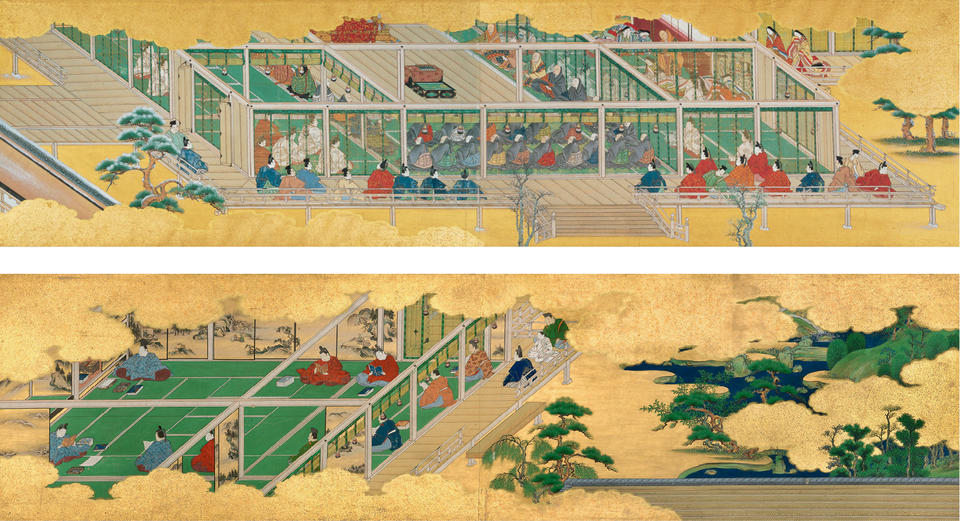Catalogue information
Edo period, ca. 1650
Two sections from handscroll mounted on wood panels; ink, color, and gold on paper
(top) 32.5 x 136 cm (12 3/4 x 53 1/2 in.); (bottom) 32.5 x 137.1 cm (12 3/4 x 54 in.)
Donated to The Metropolitan Museum of Art, New York by the Mary and Jackson Burke Foundation in 2015
Literature
Galerie Janette Ostier 1980
; 1980
Les jardins d’or du Prince Genji: Peintures japonaises du XVIIe siècle. Paris: Galerie Janette Ostier.
Murase 1983b, pp. 101–2
; 1983b
Iconography of “The Tale of Genji”: Genji monogatari ekotoba. New York: Weatherhill.
Murase 1993, no. 38
; 1993
Jewel Rivers: Japanese Art from the Burke Collection. Exh. cat. Richmond: Virginia Museum of Fine Art.
Allen 2004, p. 103 and pl. 3
; 2004
“Japanese Exemplars for a New Age: Genji Paintings from the Seventeenth-Century Tosa School.” In Critical Perspectives on Classicism in Japanese Painting, 1600–1700, edited by Elizabeth Lillehoj, pp. 99–132. Honolulu: University of Hawai‘i Press.
Inamoto Mariko 2008, figs. 1–19
; 2008
“Genji monogatari emaki. Sakaki no maki no shōkei sentaku ni kansuru ichikōsatsu” (Tale of Genji handscrolls: Thoughts on the selection of settings for illustrations of the “Sakaki” chapter). Kinko sōsho: Shigaku bijutsushi ronbunshū no. 34 (March).
Kojima Naoko 2008, pp. 76–79
; 2008
“Genji monogatari emaki / Handscrolls of ‘The Tale of Genji’; The Feast of Light and Shadow.” Iichiko: A Journal for Transdisciplinary Studies of Pratiques, no. 100 (Autumn): 76–79.
Kojima Naoko et al. 2008, pls. 1–5
; 2008
[Editors]. Genji monogatari to Edo bunka: Kashikasareru gazoku (Genji monogatari and Edo-period culture: Visualizing “Ga” and “Zoku”). Tokyo: Shinwasha.
Mitamura Masako and Geijutsu Shinchō Henshūbu 2008, pp. 132–33, 138–39
; 2008
[Editors]. Genji monogatari: Tennō ni narenakatta ōji no monogatari (The Tale of Genji: The story of a prince who could not become emperor). Tokyo: Shinchōsha.
Museum of Kyoto 2008, pp. 132–33, 138–39 (memorial service scene only), 174–76, no. 82
; 2008
Genji monogatari sennenkiten (The millennium of The Tale of Genji). Exh. cat. Kyoto: Museum of Kyoto.
Inamoto Mariko 2011, pp. 15–21
; 2011
“Maboroshi no Genji monogatari emaki Baaku-bon ni tsuite” (The lost picture scrolls of The Tale of Genjii owned by the Mary and Jackson Burke Foundation). Rikkyō Daigaku Nihongaku kenkyūjo nenpō, no. 8 (March): 15–21.
Sano Midori 2011, pp. 274–75 (plates), no. 31, pp. 328–29 (text).
2011
Genji-e shūsei (Compendium of Genji illustrations). 2 vols. Tokyo: Geika Shoin.
See also
This artwork was published as catalogue entry 78 in Volume I of Art through a Lifetime.



